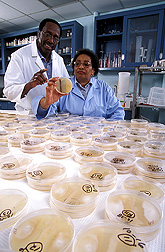This page has been archived and is being provided for reference purposes only. The page is no longer being updated, and therefore, links on the page may be invalid.
Read the magazine story to find out more. |
|
Fighting Crop-Damaging Fungi With Bacteria
By Sharon DurhamOctober 2, 2006
"Bacillus Meets Fusarium" may sound like a monster movie title, but to Agricultural Research Service (ARS) microbiologist and research leader Charles Bacon, it's shaping up to be a good battle.
Researchers in the ARS Toxicology and Mycotoxin Research Unit at Athens, Ga., have found a bacterium that can greatly reduce the colonization of corn by Fusarium verticillioides. That's a good thing, because this is a toxin-producing strain of Fusarium fungus that can reduce the marketability of crops infected with it.
F. verticillioides is an endophyte in corn—that is, it takes up residence inside the corn. Sometimes such plant inhabitants can be beneficial, but F. verticillioides clearly is not. So Bacon and microbiologist Dorothy Hinton went hunting for some "good" endophytic microbes that might squeeze the hostile fungus out.
Enter Bacillus mojavensis, a bacterial endophyte with plant-enhancing traits. Bacon and Hinton found that this bacterium, already patented by ARS to protect plants from disease, greatly reduces the amount of fungus in corn. It can naturally "infect" corn seedlings from a one-time application to seed and persist throughout the corn's growth and development.
Greenhouse trials conducted by Bacon and Hinton showed that B. mojavensis achieves up to a 70-percent reduction in fumonisin mycotoxin. Unfortunately, they found that when F. verticillioides is stressed, it produces fusaric acid, which is toxic to the bacterium.
For two years, Bacon and Hinton searched for a mutant bacterial strain resistant to fusaric acid, but still capable of controlling the fungus. They found two strains that they say provide the biocontrol tools needed for more-effective field studies in corn and wheat.
Discovering that B. mojavensis forms natural endophytic associations with a wide range of plants is expected to influence the basic approach of using bacterial endophytes as a biocontrol strategy for protecting all plants. The approach offers many advantages over traditional biocontrol bacteria because endophytes are systemic and persist as long as the plant host is alive.
Read more about this and other food safety research in the October 2006 issue of Agricultural Research magazine.
ARS is the U.S. Department of Agriculture's chief scientific research agency.

